Agile Project success rates are 2X Higher than Traditional Projects. Do you have the right approach?
By now, you’ve likely heard about Agile development and all the benefits of gathering continuous feedback while building products incrementally. In fact, you must have decided to build your next project using Agile. But where do you start?
Scrum and Kanban are the most popular ways to approach Agile development today. Both these methodologies have their advantages, and the better choice depends on the team size and product you are building. In this article, we’ll explain where Scrum and Kanban work well, how both the practices differ from each other, and how to choose the right methodology for your team.
If you want to enrich your career and become a professional in Scrum, then visit Mindmajix - a global online training platform: Scrum Online Training
Choosing between Scrum and Kanban isn’t easy. But with our article, you can easily understand the differences and determine the Kanban or Scrum, which framework is right for your team.
Kanban vs Scrum: What are the major differences?
Both Kanban and Scrum are iterative work systems that depend on process flows and improve product quality along with productivity. However, there are many differences between the practices.
| Parameter | Kanban | Scrum |
| Roles and Responsibilities | No required roles. | A Scrum master, product owner, and development team members make up the Scrum team. |
| Cadences | Continuous flow | Regular fixed-length sprints |
| Workflow | There are no time-based restrictions. It follows a three-step workflow: To do, in progress, and done. | The work has to be finished within the predefined time period. |
| Release methodology | Continuous delivery | At the end of each sprint. |
| Commitment | In this, commitment is agreed upon based on team capacity. | The team uses sprint forecasting to check how much work can be done and try to meet the forecast by the end of the Sprint. |
| KPIs | Lead time, cycle time | Velocity is key. Burndown charts describe the work completion status. |
| Meetings | Optional | Sprint cycle consists of Sprint planning, Daily Scrum, Sprint Review, and Sprint retrospective |
| Boards | Columns are labeled likewise for displaying workflow requirements and also to publish the maximum no of stories at once | Columns are labeled for reflecting workflow periods from starting through the team’s definition of done. |
| Delivery timelines | Products and processes are delivered on an as-needed basis continuously. | Sprints determine the deliverables. |
| Best applications | Suitable for projects with widely varying priorities | Ideal for projects with stable priorities that may not change over time. |
Roles and Responsibilities in Kanban and Scrum:
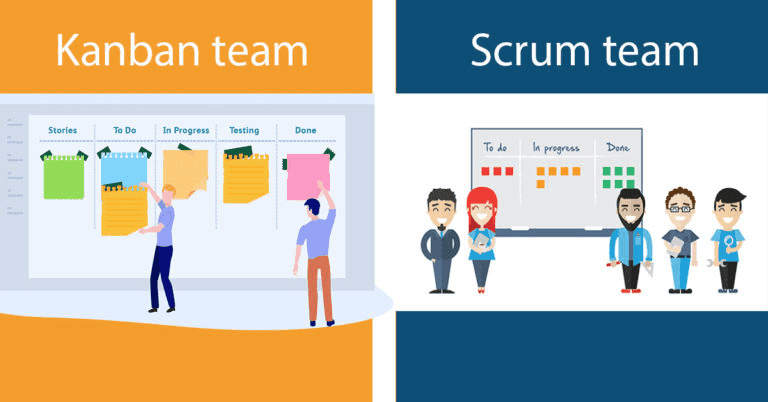
Kanban team doesn’t have any predefined roles. But, there are two Kanban roles which we can implement:
- Service Delivery Manager
- Service Request Manager.
Service Delivery Manager makes sure the work items pass efficiently throughout the process and assists the team members whenever required.
Service Request Manager is responsible for managing the process policies and consistency, by improving the governance and reducing the risks. This person is usually a secondary role of the team manager.
Scrum team contains predefined roles:
- Scrum master
- Product Owner
- Scrum Development
The product owner is a key stakeholder and in charge of the backlog who defines the goals, the Scrum master dictates timelines, and the development team executes the work. Scrum teams are self-organizing, and every role is equal, despite having different responsibilities.
[Related Article: Scrum Master Roles and Responsibilities]
Process Cadences in Scrum and Kanban:
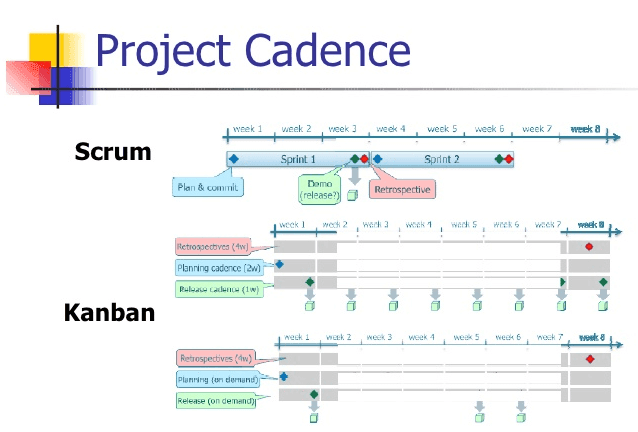
Cadences are part of both Scrum and Kanban, but its implementation is different.
In Scrum, Cadence is defined as a pulse of sprint starts, finishes, and more importantly, the outcomes. If every item that was chosen was completed, then Sprint is successful and Viceversa.
Sprints are punctuated by planning, review, retrospective meetings, and daily scrum meetings. Scrum ceremonies are lightweight and run on a continuous basis.
In Kanban, there are no iterations or sequenced time boxes. Here, cadences are related to meetings and are optional. While the goal is to maintain continuous flow work, the Kanban methods are iterative in nature. Continuous improvement is expected to be evolutionary as work is continually happening at all necessary levels.
The workflow in Kanban and Scrum:
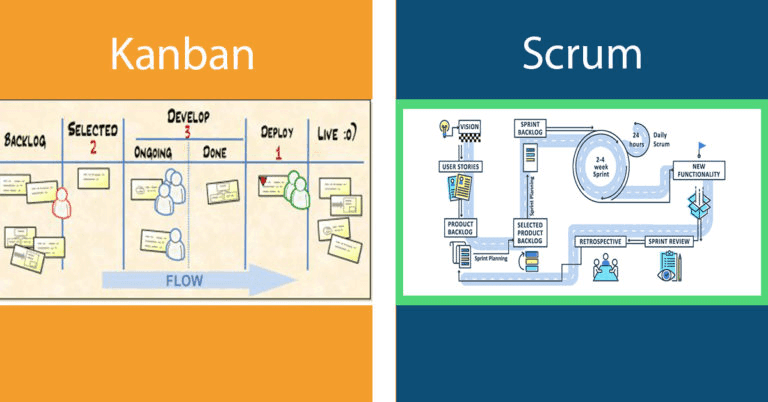
In Kanban, the main objective is to achieve a continuous flow. That’s why there are no time-based restrictions. Instead, it is based on improving efficiency.
Scrum is a time-boxed framework and iterations are fixed in durations known as Sprints. Iteration can be 2 to 4 weeks long, and work should be finished within this defined period.
How Scrum Release Methodology differs from Kanban Release Methodology:
In Scrum, the ad-hoc releases are released at the end of each Sprint. Teams set the objective for each Sprint, sprint goal, and approves the release in the sprint review meeting. Changes during the Sprint are strongly discouraged.
In Kanban, without any regular schedules or predetermined due dates, updates are released whenever they are ready. Changes can be made to a project mid-stream, allows iterations and continuous improvements before project completion.
[Related Article: Scrum Tutorial For Beginners]
Commitment in Kanban and Scrum:
Kanban supports the deferred commitment and provides a set of rules and practices to ensure agility and deliver value at the right time. In doing so, the service delivery of customer requests is more predictable and reliable.
In Scrum, commitment is essential to build an agile culture. It is a requirement for teams to commit a particular amount of work. Using a time framework, Sprint checks the amount of work finished and can be done by the end of the Sprint.
What are the key metrics that improve productivity and software quality in Scrum and Kanban?
While choosing Scrum vs Kanban, we can’t ignore the key performance indicators that optimize the workflow performance.
In Scrum, there are two specific KPIs to focus on:
- Velocity
- Planned capacity
Velocity is a crucial planning tool that shows the status of work completion. It compares the story points completed in the last Sprint to those achieved in the current Sprint. Helpful for estimating accuracy from Sprint to Sprint and future sprint planning.
The planned capacity helps you to estimate the availability of the team for the Sprint. It determines how many product backlog items to plan for a sprint. If capacity is expected to be less, the team should consider taking fewer items from the product backlog and vice versa.
Usually, scrum teams perform a couple of charts to have a check on them:
- Velocity charts
- Burndown Charts
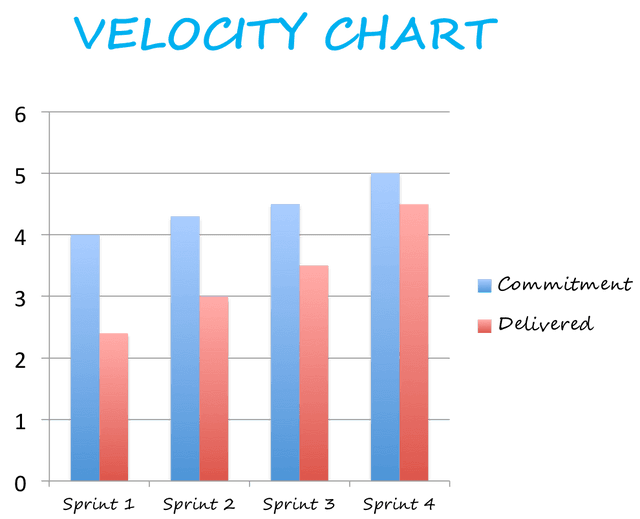
A velocity chart shows the sum of estimates of the work delivered across all iterations.
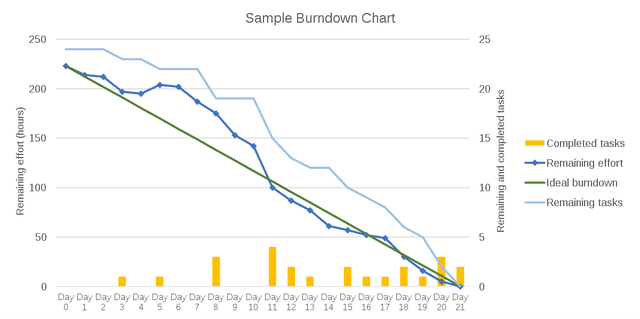
Burndown chart is a visual representation of how much work remains to be completed versus the remaining amount of time in the Sprint.
Related Article: Scrum Workflow
In Kanban, there are two essential metrics for teams:
- Lead Time
- Cycle team
These metrics are the ones to watch to make sure to deliver results for customers. They deal with the average amount of time taken for a task from start to finish. In simple words, a lead time is the time period between a new task’s appearance in the workflow and its final departure in the system.
On the other hand, Cycle time starts at the moment when the arrival enters the progress stage and someone is actually working on it.
The cumulative flow diagram is another analytic tool used by the Kanban teams to check work items in each state.
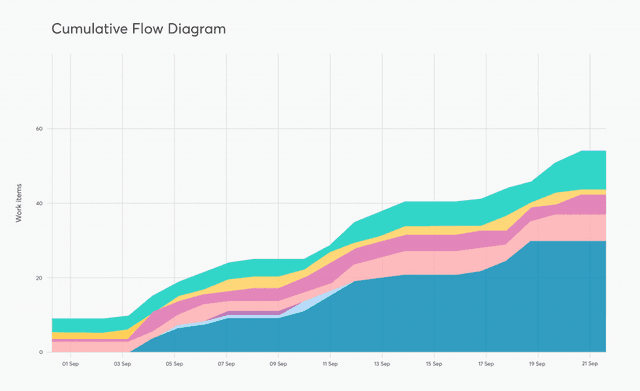
It shows the results of how stable the workflow is and helps you understand where you need to focus in order to make your process more predictable. In fact, CFDs also help you to identify bottlenecks that are going to develop.
Another essential metric to consider in Kanban is Bottleneck. The bottleneck signals the team about the resource capacity for handling workflow. We can easily spot the bottlenecks as they occur: indications to watch out for decreasing throughput, increasing cycle times, and a sharp increase in gradient in your cumulative flow diagram.
Kanban meeting vs Scrum meeting: What’s the difference?
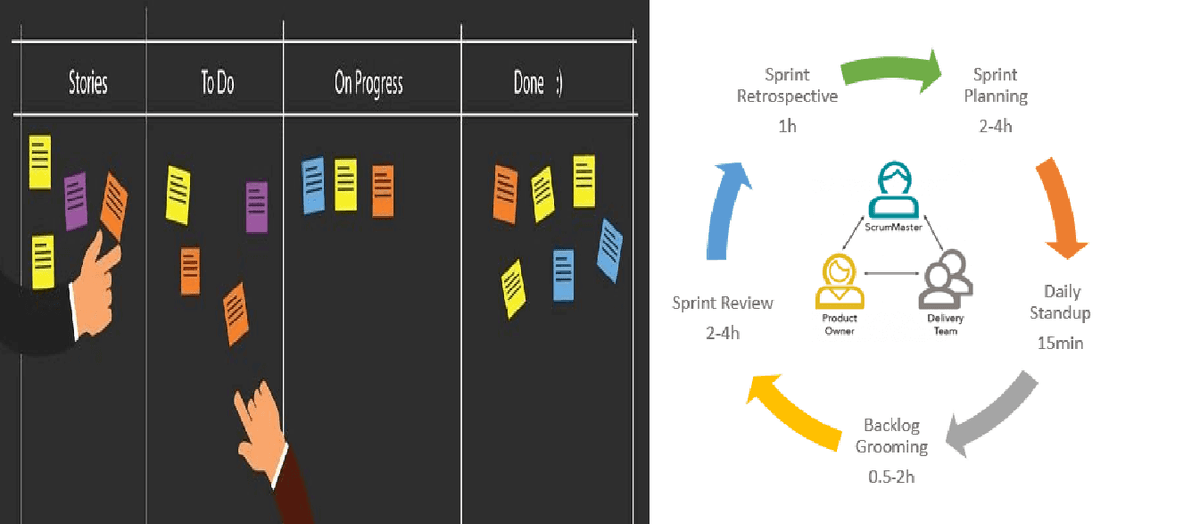
The goal of Kanban Meetings is to reduce the time spent on all tasks. While the Kanban boards are optional, but if you want to implement them, you have to choose the following types to keep your team aligned:
- Daily Meeting
- Service Delivery Review
- Strategy Review
- Delivery Planning Meeting
- Replenishment & Commitment Meeting
- Operations Review
- Risk Review
Scrum meetings focus on people. Each sprint cycle consists of four essential types of meetings:
- Sprint planning
- Daily Scrum
- Sprint review
- Sprint retrospective
Sprint planning is held at the starting of every Sprint. This team communicates the amount of work to be completed in a specific time frame, and at the end of this meeting, the development team comes back with the sprint goal and backlog. After everything is assigned, daily scrum meetings occur on a regular basis to discuss the progress.
After finishing every Sprint, a sprint review meeting is held to describe the purpose of the product and what has been gained during a specific Sprint. At last, a retrospective occurs to analyze what worked and what improvements needed to be made in the next iteration.
Kanban boards vs Scrum boards: How are they different?

While both the work boards look similar, still they are different. Kanban boards use columns, cards, and continuous improvement to help technology and service teams to commit the right amount of work. Columns labeled likewise show workflow statuses but the only difference is by publishing the maximum number of user stories in each column at any time. A proper Kanban board has WIP limits visualized on it.
On the scrum board, columns are labeled to indicate periods in the workflow starting from the sprint backlog and finishing with the team’s definition of done. User stories are added to the board at the sprint beginning and can be found at the final column of the Sprint, or the Sprint was unsuccessful. The board is cleared and prepared for the next Sprint after the sprint retrospective.
Scrum tools vs Kanban tools:
- Once you’re aligned with the Scrum or Kanban approach, then it’s time to find some tools that serve you well.
- The tools that allow Scrum into your workflow are nTask, Targetprocess, Asana, ScrumDesk, OrangeScrum, and more.
- Software tools that allow Kanban into your work pattern are Kanbanize, KanbanFlow, Trello, Leankit, Zenhub, and more.
[Related Article: Frequently Asked Scrum Interview Questions]
Why Scrum is better?
Scrum is structured. If you want to work on a project that wants more specific roles and procedures, then Scrum is a go-to choice. Another benefit of using Scrum is team accountability.
Daily standups and retrospection meetings help the team evaluate their positions, and this naturally adds high transparency and visibility of the projects and keeps team members accountable for their work. Because of its speed and tendency, it’s highly suitable for small teams and startups.
Why Kanban is better?
Kanban is great to improve workflow and reduce the time cycle of the project. If you’re looking for a methodology that improves productivity by allowing changes at any time, then Kanban is for you. Kanban’s flexible structure allows you to implement changes quickly, and essential virtualization ensures the overall team’s transparency.
Anyone in the team has access to Kanban boards, and the main benefit of using Kanban is limiting work in progress prevents the team from becoming overloaded. Kanban is the more preferred approach for projects that require continuous improvements.
Scrum or Kanban - Which is better for your team?
Choosing Scrum or Kanban is really hard. Both are proven process tools for project management. Before deciding between these two methodologies, make sure it fits your business requirements.
If you need a structured approach and the client is more specific about requirements from starting to end, then Scrum is a more likely option that improves the overall process and finishes projects quickly. While Kanban is great if you want to manage complex projects across all company levels.
With this, we have come to the end of the article. We hope now you got a clear idea of what Scrum and Kanban are about and how they are useful. Both look similar, but as seen above they have some major differences indeed.
If you want to know more about Kanban and Scrum, check out our compendium of tutorials and articles.
 On-Job Support Service
On-Job Support Service
Online Work Support for your on-job roles.

Our work-support plans provide precise options as per your project tasks. Whether you are a newbie or an experienced professional seeking assistance in completing project tasks, we are here with the following plans to meet your custom needs:
- Pay Per Hour
- Pay Per Week
- Monthly
| Name | Dates | |
|---|---|---|
| Scrum Training | Dec 20 to Jan 04 | View Details |
| Scrum Training | Dec 23 to Jan 07 | View Details |
| Scrum Training | Dec 27 to Jan 11 | View Details |
| Scrum Training | Dec 30 to Jan 14 | View Details |

Madhuri is a Senior Content Creator at MindMajix. She has written about a range of different topics on various technologies, which include, Splunk, Tensorflow, Selenium, and CEH. She spends most of her time researching on technology, and startups. Connect with her via LinkedIn and Twitter .














